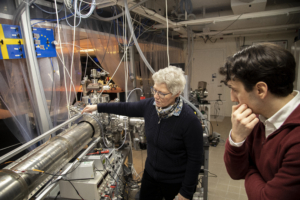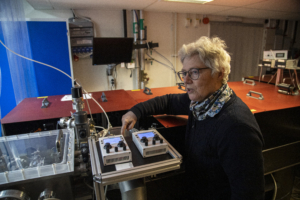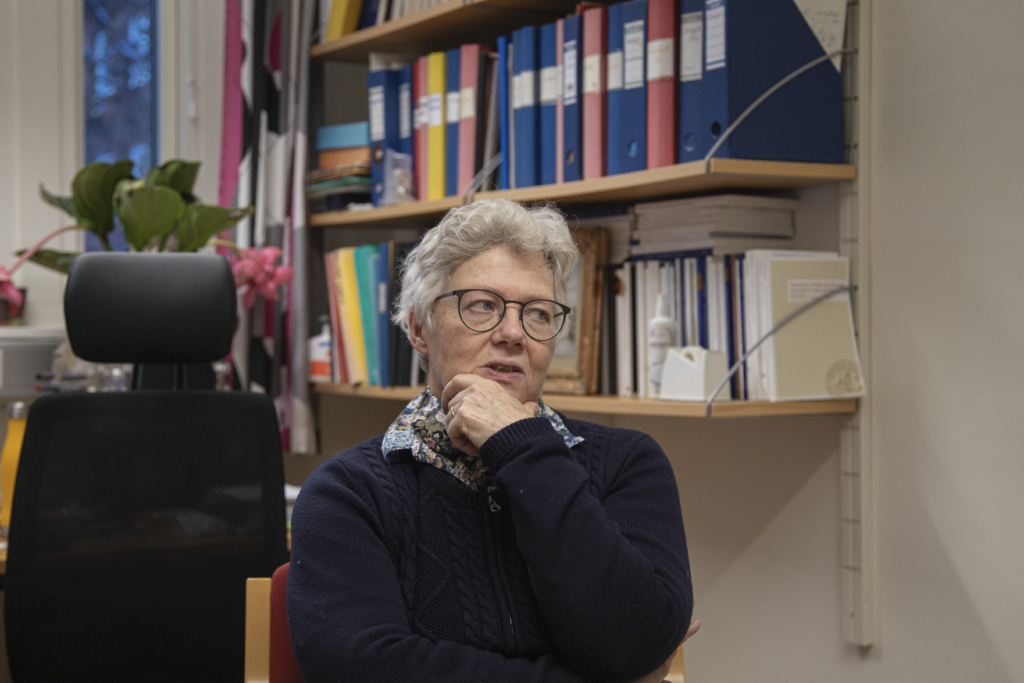On the third of October 2023 it was announced that the Nobel Prize in physics would be awarded to Anne L’Huillier, the first time a researcher at Lund University was given the prize.
– I think, to be a good researcher, one has to be obstinate to continue working in spite of what others say, she says.
On the fourth of January, Anne L’Huilier sits working in her simple office in the depths of the maze-like Fysicum building in Lund. She was crowned as the most awarded researcher and received a gold medal from Lund University just before receiving the 2023 Nobel Prize in Physics in december. With so many academic achievements under her belt, such as the Wolf Prize in physics, the French Legion of Honour, and the Max Born Award, she is no stranger to the podium. But, as professor L’Huillier came to experience, nothing can prepare you for winning the Nobel Prize.’
I don’t consider myself a celebrity, and I don’t want to be one.
– It’s very overwhelming. Of course, I’m very happy to have this prize. I feel a little bit the duty to communicate this science to society. I’ve had 1,700 emails related to the Nobel Prize. And, I would say 1,400 during the first week. All of these people write to me and congratulate. I mean, what I have to do is to answer them. Otherwise, it’s very impolite.
– I don’t consider myself a celebrity, and I don’t want to be one, she says.
The Nobel Prize in Physics was announced when Anne L’Hullier was in the middle of a lecture at Fysicum, and despite the extraordinary news, she wanted to continue her lecture. At several occasions she has stressed the importance of good teachers, both for her personally and for the science community at large.
– For me, teaching is communicating. I need this communication myself as a teacher to have a good lecture. I am always trying to answer all the questions, and I am actually trying to stimulate these questions. This is my way of teaching, she explains.
This emphasis on communication has led Anne L’Huillier to become a beloved teacher and mentor in the physics community, along with her successful academic career. Per Eng-Johnsson, her doctoral student since 20 years, says, ”She empowers young researchers,” during an interview with Lund University. Anne L’Huillier cannot stress enough the importance of passion in your career.
– It is important to do what you want and what you find interesting. Try to follow your intuition. Don’t choose something because others do it or because your parents say that is what you should do.

Childhood memories and early role models can have a large impact on what a person chooses to pursue later in life. When asked about which specific people or events have influenced her career as a physicist, Anne L’Huillier remembers both the global and the personal.
– Apollo 11 is something I remember very, very clearly. It was really extraordinary to watch all the science and technology behind putting a man on the moon. Maybe my grandfather is also a strong inspiration. His teaching, research and use of technology in the Second World War to help the resistance movement impressed me as a child, she says, and continues:
– I think to have been inspired by very good teachers in the university has been very important for me… Two of them got the Nobel Prize afterwards. They were Claude Cohen-Tannoudji and Serge Haroche. They inspired me by the way they taught.
By receiving the Nobel Prize herself, Anne L’Huillier is among the ranks of the greatest minds in the history of physics. Thinking of her journey from student to master, she ponders the possibility of one of her students one day receiving a Nobel Prize of their own.
– If this happens, especially during my lifetime, it would be really fantastic. To educate young people, to have been their teacher and their mentor means a lot to me, she says.
During her Nobel Prize acceptance speech, Anne L’Huillier talked about the gender disparity within the physics community. Noting that there were only two female physics laureates from the prize’s inception in 1901 until 2017. Including Anne L’Huillier there have been three female laureates from 2018 and onward.
While she hopes that the trend of women physics laureates can help inspire future generations, more time is needed to reach gender equality within the field of physics.
– There is still an obvious imbalance between men and women in physics in terms of the number of people, that is clear. There is a strong pressure on both men and women to change that. What I wanted to say [in my acceptance speech, reds. anm.] was that it is changing. Maybe it takes longer than one wants to, but this time is needed, she says.

Anne L’Huillier and her colleagues Pierre Agostini and Ferenc Krausz recieved the Nobel Prize ”for experimental methods that generate attosecond pulses of light for the study of electron dynamics in matter.” Very rapid movements, such as a hummingbird flapping its wings, blur when observed with the naked eye. When studying the much faster movement of significantly smaller objects, such as electrons, very specific tools are required. Attosecond pulses are very, very short light pulses which enable us to study processes that happen in a very, very short time span.
– My group and I discovered, at the end of the 80s, the generation of higher-order harmonics of laser. So this is very much like music. You produce a sound… this sound is generally not just a tone, but the tone plus overtones. If you put all of these harmonics together, you get a series of very, very short light pulses, she explains.
The Nobel Prize mirrors the reality that was thirty years ago.
The attosecond pulses that Anne L’Huillier and her collaborators have discovered might seem incredibly difficult to grasp for most people. But the beauty of physics is how it can show up in all parts of life, some more easily accessible than others.
– I like this parallel with music because people recognize it… people can relate to music more than light, actually. My youngest son is a musician, and he was present at the Nobel lecture, so I thought, oh, I need to try to talk to him so that he can understand, she says.
In the world of science, recognition is not always delivered on time. Anne L’Huillier and her team made the discovery that opened the field of attosecond physics all the way back in 1987.
– The Nobel Prize mirrors the reality that was 30 years ago. Almost more than 30-36 years ago the discovery was made, so there is a delay.
Initially, Anne L’Huillier’s research went against what people thought in her field. However, she trusted her intuition and believed her research would lead her onwards.
– I think to be a good researcher, one needs to be obstinate and to continue working in spite of what others say. You also need to be passionate about what you do.
This article was first published in Lundagård no. 1 2024.









